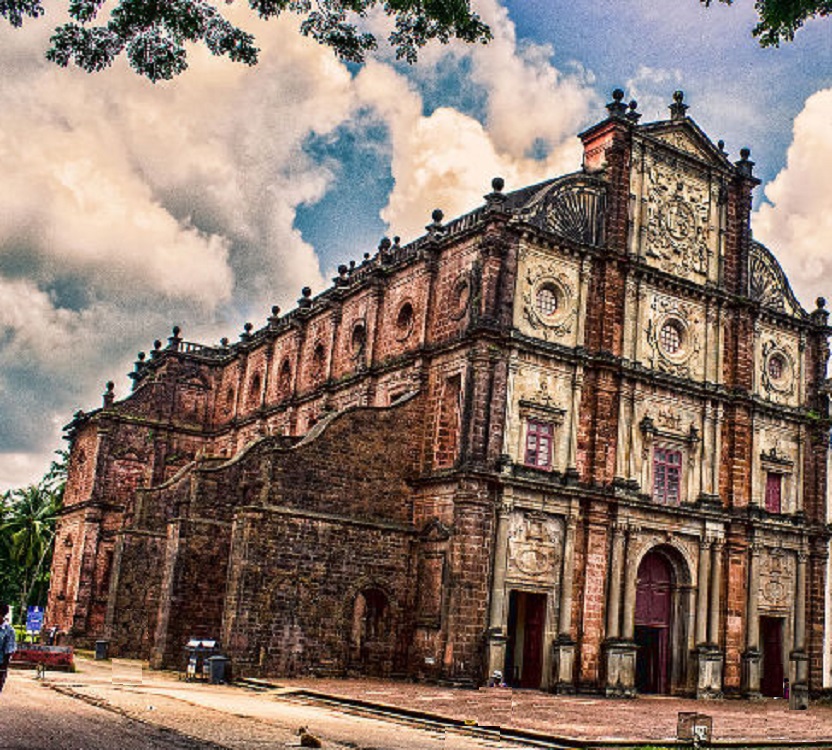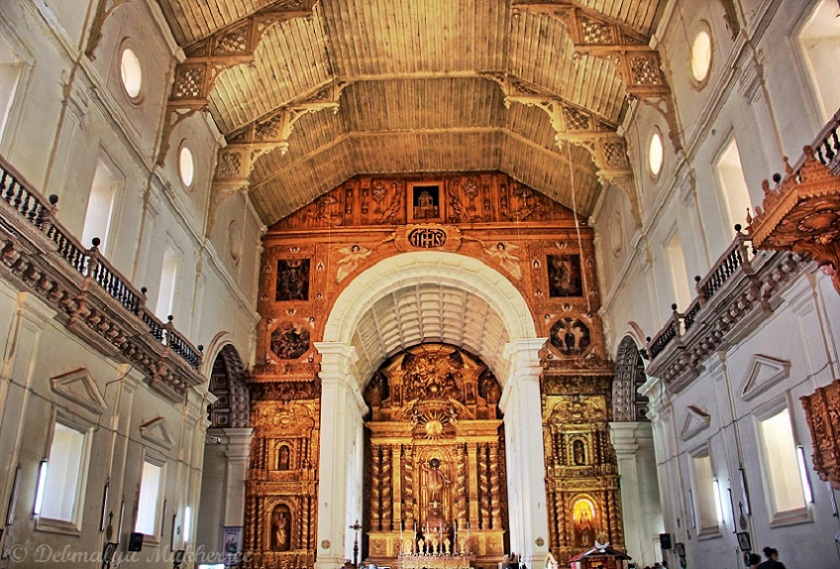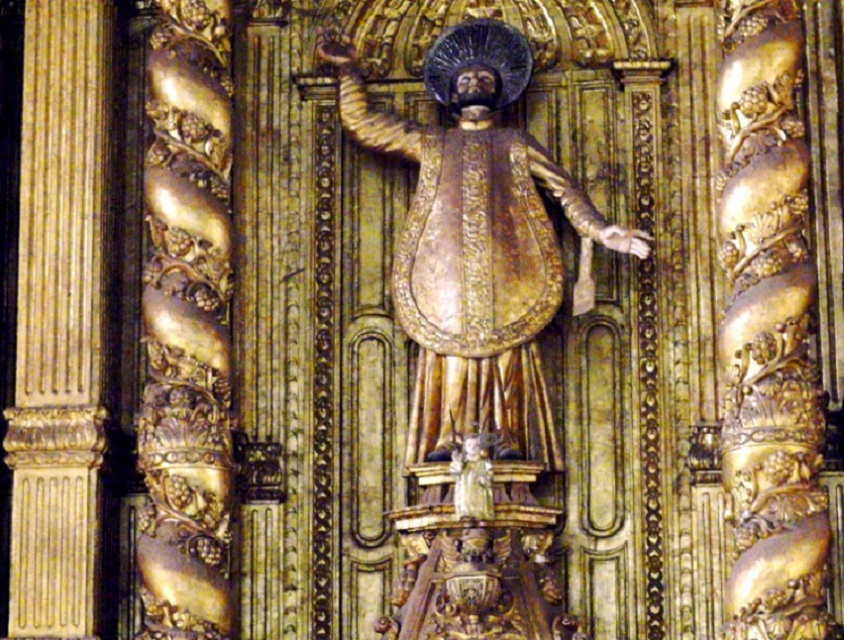Basilica of Bom Jesus, Old Goa
This is a collection of articles archived for the excellence of their content. the Facebook community, Indpaedia.com. All information used will be acknowledged in your name. |
Contents |
The Basilica of Bom Jesus
By Goa Tourism, with inputs from Interesting facts about the 400 years old Bom Jesus Church in India, the final resting place of St. Francis Xavier| Catholic Online News Home & Family Living Faith| 29/9/2014
History
The Bom Jesus Basilica, Goa's most famous church and among the most revered by Christians worldwide, is partially in ruins but still a model of simplicity and elegance, and a fine example of Jesuit architecture.
This is the only church in Old Goa, which is not plastered on the outside, the lime plaster having been stripped off by a zealous Portuguese conservationist in 1950.
Located at Old Goa, 10 kilometres east of Panaji, the Bom Jesus Basilica is a World Heritage Monument.
St. Francis Xavier died on 3rd December 1552, on the Chinese island of Shangchuan, at the age of 46. Before his final resting place in the Basilica of Bom Jesus in 1624, his body was buried in three different countries. Each time the body was exhumed, it was found to be fresh and incorrupt. His body was brought back to Goa after two years, in accordance with his wish. The body of St Francis Xavier, when brought to Goa, was laid in St. Paul's church.
St Francis was regarded as a saint during his lifetime, and was canonized in 1662. His remains are ensconced in a glass container encased in a silver casket in the Basilica. It was after St. Francis Xavier was canonized, in 1662, that the body was shifted to Basilica of Bom Jesus, where it remains till date.
The mausoleum, on the top of which is the silver casket that holds the body of Saint Francis Xavier (1696), was the gift of the last of the Medicis, Cosimo III, The Grand Duke of Tuscany.
The basilica is one of the oldest churches in Goa. It stands carpeted with marble flooring and inlaid with precious stones.
Architecture
The foundation stone of this remarkably large church was laid on 24 November 1594 and the church was consecrated by the Archbishop, Dom Fr. Alexia de Menezes, the Archbishop of Goa and Primate of India consecrated it when it was completed on 15 May 1605. In 1946 it was raised to the status of a minor Basilica.
The Order of Jesuits was suppressed in 1759 and its property confiscated by the Portuguese State. The church was, however allowed to continue services.
This magnificent edifice stands as a superb example of Baroque architecture in Goa. The church is called "Bom Jesus" meaning 'good Jesus' or 'infant Jesus' to whom it is dedicated. The façade has on it, at the top, the letters, "HIS" which are the first three letters of Jesus in Greek.
The imposing facade built out of black granite in an exquisite combination of the Doric, Corinthian and composite styles, is remarkable for its simplicity. It measures 183 ft in length,55 ft in breath, and 61 ft in height. The main altar is 54 ft high and 30 ft broad. The pillars and detail are carved from basalt which was brought from Bassein, some 300 kms away. The interior of the church is built in Mosaico-Corinthian style and is remarkable for its charming simplicity.
The roof was originally tiled. The church is cruciform on plan. The flying buttresses on the northern side of the church are recent additions. A single-storeyed structure adjoining the church on its southern wing connects it with the Professed House.
The three-storeyed facade of the Church shows Ionic, Doric and Corinthian Orders, and has a main entrance flanked by two smaller ones, each having Corinthian columns supporting a pediment. There are two chapels, a main altar and a sacristy besides a choir inside the Church itself. There is a belfry is at the back.
As one enters, beneath the choir, to the right is an altar of St. Anthony and to the left is an exceedingly well-carved wooden statue of St. Francis Xavier. In the middle of the nave on the northern wall is the cenotaph of the benefactor of this church, Dom Jeronimo Mascarenhas, the Captain of Cochin, who died in 1593, bequeathing the resources out of which this church was built. The two columns supporting the choir bear slabs inscribed in Portuguese and Latin the dates of beginning of construction and the consecration.
Opposite the cenotaph, projecting on the southern wall is a profusely carved wooden pulpit with a canopy on top. The pulpit has on its three sides the figures of Jesus, the four evangelists and four doctors of the church. The bottom of the pulpit depicts seven figures as though supporting it.
A projecting gallery, which was intended for the use of dignitaries on solemn occasions, runs along the two longer sides of the Church.
The main altar at the end of the nave is flanked by two decorated altars in the transept, one dedicated to Our Lady of Hope and the other to St. Michael. The richly gilded main altar has the figure of infant Jesus and above it is a large statue of St. Ignatius Loyola, founder of the order of Jesuits, gazing with fervour at a medallion on which is inscribed "HIS". Above the medallion, the Holy trinity - the Father, the Son and the Holy Ghost are depicted. In the transept on the northern side is the Chapel of the Blessed Sacrament.
On the southern side in the transept is a chapel with gilded twisted columns and floral decorations of wood, where the sacred relics of the body of St. Francis Xavier are kept. The interior of this chapel is richly adorned with wooden carvings and paintings, depicting the scenes from the life of the Saint.
A beautiful silver statue is kept in front of the casket. The silver casket, which serves as a reliquary containing the sacred relics of the body of St. Francis Xavier, is exquisitely carved, and was once studded with precious stones. The casket is divided on each side into seven panels, each of which has two plates representing in relief important incidents in the life of the saint.
Adjoining the Chapel of St. Francis Xavier is a corridor that leads to the sacristy, entered through an exquisitely carved wooden door. It is an oblong vaulted structure with an apse at the end. Alongside the walls are kept the portraits of various saints above delicately carved chest of drawers. In the altar at the apse in an iron chest containing a golden rose blessed by the Pope Pius XII and gifted to this city in 1953. At the foot of the altar is the grave of the founder of the vestry, Balthazar da Veiga who died in 1659. A painting giving a fair idea as to the state of the body of St. Xavier about a hundred years ago is displayed near the altar.
Inside the basilica the layout is simple but grand. A simple wooden one has now replaced the original vaulted ceiling. To the left of the door as you enter the basilica is a statue of St. Francis Xavier, but the visitor's attention is drawn to the huge and ornate gilded reredos which stretches from floor to ceiling behind the altar.
The Professed House
The Professed House of the Jesuits located next door to the Basilica is a two storey laterite building covered with lime plaster which actually predates the Basilica, having been completed in 1585 despite strong opposition to the Jesuits. Jesuit missions to the eastern regions were planed and organised from here.
Completed in 1589 under the able supervision of Br. Domingos Fernandes, the Cassa Professa or the "Professed House" according to Jesuit law is one which is intended for the exercise of the ministries of the Society and should be conspicuous for the exactness of the Jesuit way of life.
There is an extremely interesting story behind the construction of the Church. The Jesuits faced strong opposition from the Senate, the Santa Cassa da Misericordiaa and the Franciscans for their planned construction in the spacious square called Terreiro dos Gallos. However on the night preceding the day on which they were to be legally restrained from building the site, two fathers and one brother converted a small house into a temporary church and on its door inscribed the word 'JESUS'.
The next morning the Church was thrown open and a bell rang to call the surprised people from the neighbourhood to celebrate mass. After that the opponents were never able to dislodge the occupants.
The ravages of time and the raging flames of the great fire in 1663 destroyed some of its lengthy corridors and spacious apartments but it was rebuilt in 1783. One more storey on the top was demolished between 1886 and 1887.
Today there's a modern art gallery attached to the Basilica.
Public viewing of the body of St. Francis Xavier is held every ten years. This event attracts lakh of pilgrims from around the globe.
THE BODY OF ST. FRANCIS XAVIER
St. Francis Xavier died on 3rd December 1552, on the Chinese island of Shangchuan, at the age of 46.
Before his final resting place in the Basilica of Bom Jesus in 1624, his body was buried in three different countries. Each time the body was exhumed, it was found to be fresh and incorrupt.
St Francis was regarded as a saint during his lifetime, and was canonized in 1662. The body, having resisted extensive decay, is now in the Basilica of Bom Jesus in Goa, where it was placed into a silver casket on December 2, 1637. The silver casket is lowered for public viewing only during the public exposition which occurs for a duration of 6 weeks every 10 years, the most recent of which took place in 2004.
For the first time the Body of St. Francis Xavier was exposed for public veneration in the Church of S. Paulo in an open coffin, on March 16, 17 and 18 of 1554 soon after it was brought to Goa. On the fourth day it was buried near the main altar. It was exhumed six years later and never buried again. In 1665 the relics was taken to the present Chapel. Over the years there have been numerous private and public expositions of the scared relics of St. Francis Xavier. The vestments of the saint, the coffin where is lays, the casket that hold the coffin and the tomb where his relics rest have also undergone changes over the years. Numerous miraculous healings have been recorded and verified on many occasions.
The various expositions have been marked by various events held such as release of stamps in honor of the saint, exhibitions of Sacred Art, Industrial and Agricultural exhibitions. The last exposition was held 10 years ago in 2004 from 21stNovember 2004 to 2nd January 2005 with the theme ” As fellow Pilgrims Nourished by the Eucharist sent to Build Communion “. The exposition of the sacred relics is held every 10 years.
See also
Basilica of Bom Jesus, Old Goa


